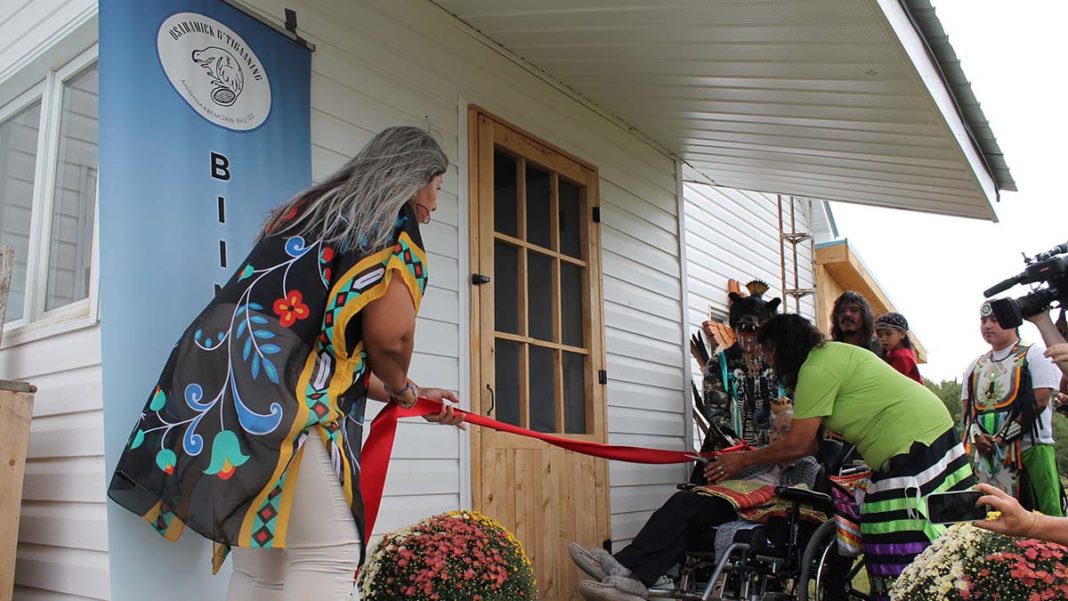Osawamick Ranch an immersive land-based Anishnaabemowin learning camp
WIIKWEMKOONG—At Wiikwemkoong’s Osawamick G’Tiganning, Anishnaabe Enji-Teg Osawamick Ranch, the Anishnaabemowin language and culture is always at the forefront.
“It’s a place where people can come listen and learn from fluent speakers in the Anishnaabemowin language and to learn the language while listening, cooking or participating in other activities that they would in their everyday life,” stated Nicole Van Stone, program manager of Osawamick G’Tigaaning, Anishnaabe Enji-Teg Osawamick Ranch.
The Anishnaabemowin school opening comes following news from the 2021 Canadian census that shows roughly 243,000 people reported being able to speak an Indigenous language, a decline from the 2016 census when that figure was around 251,000. There has been a significant increase over the same time in terms of the number of children aged eight or younger who can speak an Indigenous language. It was the only statistic in all the different age categories to show an overall increase.
There have long been concerns about the fragility of Indigenous languages. Depending on the language, some Indigenous communities say they only have a limited number of speakers left. The census data suggests that among people 94 or older, the number of Indigenous-language speakers fell to 120 last year from 575 in 2016, while among the interwar generation of people aged 76 to 93, that number dropped to 9,230 from 14,120.
“It was said by an elder that we are not losing our language, our language is losing us,” stated Ms. Van Stone. “The number of language speakers is decreasing, while more people want to learn the language. The Osawamick ranch provides a place to learn the language and cultural teachings where people can feel at home and in a safe environment.”
The grand opening of the facility in late August is being welcomed by Aboriginal leaders. Barbara Nolan, language commissioner for the Anishinabek Nation (who is originally from Wiikwemkoong) says, “everything, all the activities in the house will be done in the language. People will be able to learn from experts in the language, while they learn the language and take part in cultural activities.”
“This school is huge for developing and greatly expanding the number of people who know the language, especially for younger children, that’s where we have to start with, with children,” said Ms. Nolan.
“It is a very good thing and I would like to think politicians everywhere should be keeping an eye on this,” said Ontario Regional Chief Glen Hare. “We love our language, and our own language school has now been opened in the community, and it is our people that are doing it ourselves. And hopefully more will be opened across the province.”
“This place is awesome,” stated Chief Hare. “I hope the federal government comes up with funding support for these type of facilities.”
Osawamick G’Tigaaning, Anishnaabe Enji-Teg is a year-round immersion language, land-based learning camp situated in Wiikwemkoong. It is the vision of Beverley Naokwegijig and is modeled similar to Mary Murray Culture Camp in Sugar Island, Michigan, where she worked for many years.
The efforts of Osawamick G’Tigaaning to create a safe space for immersion Anishnaabemowin learning and to bring the languages back to life along with a reconnection to culture will have a huge, positive impact on individuals, families and communities. Statistics and studies have shown the most effective and quickest way to healing is reconnection to language and culture.
Ms. Naokwegijig said that it has been her dream to have such a language house built in Wiikwemkoong for many years. “In 2011 we started the Mary Murray Cultural Camp in Sugar Island, Michigan. My sister Pat and I cooked and my sister Barbara was one of a number of teachers teaching the language.”
“All those years at the camp I said ‘we should have something similar in Wiikwemkoong,’” said Ms. Naokwegijig. The newly renovated house and freshly built cabins were her dream. She inherited the property and some money from her uncle (Bernard Osawamick, who passed away in 2019) who had stayed with her family for many years.
Her uncle provided her some money when he passed away. He did this, “probably because I told him all the time that I could fix that house and make it into a language learning house,” said Ms. Naokwegijig.
“Everyone it seemed said the house should be condemned,” said Ms. Van Stone. “But it is because of Bev, who is tenacious and knew what she wanted. She used the money her uncle had given her in his will and she used a lot more of her own money to renovate the house. The majority was due to Bev and she did it in his memory.”
Ms. Naokwegijig told The Expositor that extensive work had to be done on the house (and the cabins), such as new roofing and all new bathroom facilities.
Osawamick G’Tigaaning aims to connect people to the language and traditional culture. To provide cultural and language preservation and revitalization and to create and provide a safe space to speak the language in an immersion setting with four- to five-day programs, including meals and accommodations, “to facilitate learning commitment and a feeling of accomplishment and advancement after your stay at the ranch.”
Ms. Van Stone said, “We have been conducting culture programs here since March, starting with the Sugar Bush cultural programs. We have held a women’s retreat, and there are children’s program held every Wednesday-Thursday, along with dream catcher making, moccasins, medicine pouches, ribbon skirts, and having medicine teachers here for instance,” said Ms. Van Stone. “We also hold traditional teachings and sweat lodges. There are a number of elders from Wiikwemkooong that come in and they speak or teachers come in to do the teachings.”
“There is also soup and scone available to everyone who would like to drop in from 10 am to 2 pm, every Sunday,” said Ms. Van Stone. “And we find for all our events lots of people come in, all with different language capabilities, from beginners to those who are fluent in the Anishnaabe language.”
“We are here to provide language and cultural teachings in a safe, comfortable learning environment,” added Ms. Van Stone.





